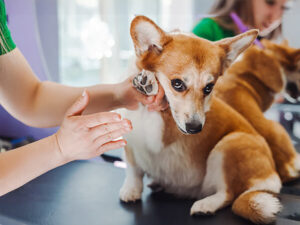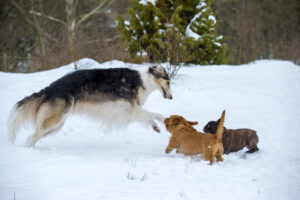Pets, especially dogs, are awesome. They bring light into our lives, create little funny moments for us to enjoy, and even serve as surrogate children or grandchildren for many owners. However, as tuned in to our pets as we may be, it’s not always possible to understand what they are experiencing, or know what to do to help them. They can’t tell us when and where they hurt, or what’s going on inside their bodies. This can make it challenging and worrisome for many owners when their pet exhibits unusual symptoms, particularly when these symptoms develop after a trip to the groomer’s. One such symptom that perplexes some owners, and may or may not be a cause for concern, is shaking or tremors.
The Shaking Pet Scenario
If you spend any time online looking at pet owner forums or discussion threads, you’re bound to come across some scenarios that, if not immediately familiar, are at least highly relatable as a dog parent. Often, you’ll see similar themes repeat themselves across multiple websites, boards, and forums. Dogs shaking or having tremors, particularly in their leg areas, starting after a grooming session and sometimes persisting for hours or even days, are one such common theme you’ll find. But is this something you need to be worried about?
Causes of Shaking, Shivers, or Tremors
Humans often shake or shiver when cold, as our bodies use the shivering mechanism to try to raise our temperature. Nerves can also cause shaking or tremors, either due to stress or excitement. These same causes can manifest in our pet dogs, alongside shaking or tremors while they sleep from vivid dreams. In most cases, these causes of shaking, shivers, or tremors are not serious, and won’t last long – though if your dog is cold, help him or her warm up with a blanket and ensuring they are dry!
There are other, more serious causes of these symptoms, however. Certain medical conditions or physical injuries can induce shaking, shivering, or tremors, either consistently or on an intermittent basis. Vertebral disc problems and nerve problems can create these symptoms, as can pain from arthritis, joint problems, or a host of other physical conditions. Palsy, as in humans, can cause shaking and jerky or random movements in dogs, though is most common in older dogs, especially after standing for lengthy periods of time.
What to Do for Your Pet
Getting at the root cause of the problem is going to take some detective work and a methodical approach.
Rule Out Pain
First, you can rule out any kind of pain situation if your pet is otherwise their normal self. If they aren’t walking in a strange way, and are otherwise eating, playing, and as physically active and able as ever, pain is usually not a culprit. By contrast, if they are in pain, they will often be less active, have trouble getting comfortable when sitting or lying down, may lose their appetite, and so on.
Consider Other Injuries or Conditions
If pain is not the cause, then some other injury or condition pathology could be to blame. Even the best grooming services and salons can have some kind of accident or event with your dog. Whether he or she tries to make a run for it and awkwardly lands from jumping off a table, or has a reaction to a shampoo or soap they are using, there’s a range of potential things that can happen. High quality groomers will inform you of any issues, even if it is their fault and may open them up to liability – they typically have insurance for those kinds of incidents, that will cover the costs associated with any veterinary care or follow-ups. Lower-quality groomers may not inform you of incidents, so you might have to do a bit more investigating and diagnosing on your own, with your dog’s regular vet.
Don’t Discount Grooming Itself as a Cause
Certain types of dogs are far more delicate than others, and if your groomer has little experience with the particular breed of your pet, you might want to look elsewhere for grooming service. With that said, even the healthiest-seeming dog and the most seasoned groomer can still result in an unknown and unintended injury or similar. You also need to consider that it might be something that was merely triggered at the groomers, and not their fault. For example, a health condition may result in temperature regulation issues after washing or bathing at the groomer – something you would have seen at home had you bathed them there – that may persist for hours afterwards. Standing for a long period of time at the groomers can also trigger shakes or tremors, especially in older dogs or those who have existing problems.
Shaking May be a Warning Sign of Something More Serious
On the flip side, some of the root causes can be more serious and require more immediate intervention. Spinal cord problems, kidney failure, nerve disease, hip dysplasia, tumors, hypothyroidism, and even low blood sugar can all cause tremors or shakes. Eating or drinking something toxic may also cause shakes or even seizures. A visit to the vet for any unexplained and prolonged (greater than an hour or so) period of time, as soon as possible, is highly recommended. Many health conditions and injuries can be most effectively treated, reversed, or managed if they are caught early enough, and, as with humans, the prognosis is best with early detection.
ALSO READ – What to Do if Your Dog is Itchy after Grooming






